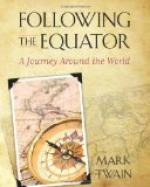And there is the case, on records where A., a settler, makes a bet with B., that B. may lose a cow as effectually as he can, and A. will produce an aboriginal who will find her. B. selects a cow and lets the tracker see the cow’s footprint, then be put under guard. B. then drives the cow a few miles over a course which drifts in all directions, and frequently doubles back upon itself; and he selects difficult ground all the time, and once or twice even drives the cow through herds of other cows, and mingles her tracks in the wide confusion of theirs. He finally brings his cow home; the aboriginal is set at liberty, and at once moves around in a great circle, examining all cow-tracks until he finds the one he is after; then sets off and follows it throughout its erratic course, and ultimately tracks it to the stable where B. has hidden the cow. Now wherein does one cow-track differ from another? There must be a difference, or the tracker could not have performed the feat; a difference minute, shadowy, and not detectible by you or me, or by the late Sherlock Holmes, and yet discernible by a member of a race charged by some people with occupying the bottom place in the gradations of human intelligence.
CHAPTER XVIII.
It is easier to stay out than get out.
—Pudd’nhead
Wilson’s New Calendar.
The train was now exploring a beautiful hill country, and went twisting in and out through lovely little green valleys. There were several varieties of gum trees; among them many giants. Some of them were bodied and barked like the sycamore; some were of fantastic aspect, and reminded one of the quaint apple trees in Japanese pictures. And there was one peculiarly beautiful tree whose name and breed I did not know. The foliage seemed to consist of big bunches of pine-spines, the lower half of each bunch a rich brown or old-gold color, the upper half a most vivid and strenuous and shouting green. The effect was altogether bewitching. The tree was apparently rare. I should say that the first and last samples of it seen by us were not more than half an hour apart. There was another tree of striking aspect, a kind of pine, we were told. Its foliage was as fine as hair, apparently, and its mass sphered itself above the naked straight stem like an explosion of misty smoke. It was not a sociable sort; it did not gather in groups or couples, but each individual stood far away from its nearest neighbor. It scattered itself in this spacious and exclusive fashion about the slopes of swelling grassy great knolls, and stood in the full flood of the wonderful sunshine; and as far as you could see the tree itself you could also see the ink-black blot of its shadow on the shining green carpet at its feet.




